FAQs About Soft/Shell Rot, Conditions In Turtles
8
Related Articles: Shell Rot in Turtles, Treating Common Illnesses of
the Red Ear Slider (& other Emydid Turtles) by Darrel
Barton, The
Care and Keeping of the Red Eared Slider, Trachemys scripta elegans by
Darrel Barton, Red Ear Sliders, Turtles, Amphibians, Red
Eared Slider Care,
Related FAQs: Shell Rot 1, Shell Rot 2, Shell Rot 3, Shell Rot, Conditions 4, Shell Conditions 5, Shell Conditions 6, Shell Conditions 7, Shell Conditions 9, Shell Conditions 10, Shell Conditions 11, Shell Conditions 12, Shell Conditions 13,
Shell
Conditions 14, Shell Conditions
15, Shell Conditions 16,
Shell Conditions 17,
& Turtles, Turtles 2, Turtle
Identification, Turtle
Behavior, Turtle
Compatibility, Turtle
Selection, Turtle Systems,
Turtle Feeding, Turtle Disease, Turtle Disease 2, Turtle Disease 3, Turtle Reproduction, Amphibians, Other
Reptiles,
|
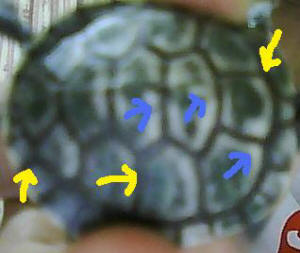
|
|
Do my turtles have severe shell rot?? --
3/31/10
Hi there,
<Hi there, Ho there!! -- Darrel here!>
Got hold of your website and have a question.
<We're glad you're here!>
Worried my turtles may have shell rot. I have three, 4 years old,
very active, healthy, good solid shell but one has a small white
spec on top shell and one has the lower shell all black (has
always been the darker guy since he was a kid).
<The pictures look OK to me, Karthik. One thing to keep in
mind is that if take a turtle with shell rot out of the water and
let him or her dry for a few minutes ... rotten shell material
will smell HORRIBLE!! Shell rot is rarely mild and NEVER a
"good" smell>
The other has lower shell little black. see pics attached. Is it
shell rot?
<I don't think so -- the coloration looks very normal to
me>
They rarely shed. They eat ReptoMin and sometimes some
carrots.
<That's fine - ReptoMin is a perfectly balanced
diet>
They bask and have uv bulb and water heater. Tank is little small
- 60 gallon but I will be upgrading soon. Using Rena canister
filter works well for now.
Thanks,
Karthik
<I think everything is fine. If they have hard shells and are
active, eating, swimming and basking then you're doing it
right!>
|
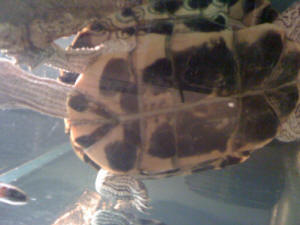 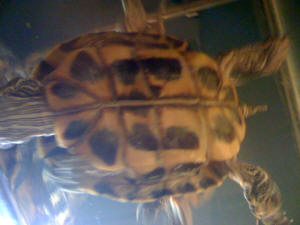 |
my turtles... RES, eye infection... soft shell... lighting,
diet 3/25/10
Hi
<Hiya - Darrel here>
I really need some help.
<OK!>
Last year I was gifted 2 red ear sliders. they have been growing well
up till now. It all started when the smaller guy had an eye infection
due to which his eyes closed up.
<Eye infections in Red Eared Sliders are almost always a sign of
vitamin deficiency due to improper diet. Lack of Vitamin A and access
to UV-B lighting>
We took him to the wet to get him treated . the swelling came down but
his eyes still refused to open but since we have been force feeding him
he's still growing well. the other guy however has become really
sick. he refuses to eat . and has developed a very soft shell.
<Another sure sign of diet deficiency and lighting problems!!
Turtles can't synthesize or even process Vitamin D without UV
light. Lack of natural sunlight, or a UV lamp PLUS a balance diet are
required?
We are pretty sure he cant see either since he no longer reacts if you
put your hand close to him . he's also started floating around in
this weird way , almost lopsided . he doesn't swim anymore he just
floats around with his legs stretched behind him. he also has no energy
. can you please tell me what's wrong with him and how I can help
him. the vet in my area is pretty useless as he says he's only for
domestic and not wild animals so I have no idea what to do . please
help
<Happy to help, Debby '¦. If it's not too late. The
second guy needs immediate veterinary attention!! A complex vitamin
shot, perhaps some calcium as well. Then, when you get him back -- keep
him warm and dry and see that he gets at least 20 minutes of natural
sunlight at least twice a day. The sunlight cannot be filtered through
glass or even window screen, as that eliminates a significant amount of
the beneficial light waves.>
<Here is a link for treating illnesses in these turtles.
http://www.wetwebmedia.com/FWSubWebIndex/treating%20RES%20Dis%20DarrelB.htm
Make sure you read and understand all the elements that go into the
treatment and begin giving him this care immediately! I'd treat
both of them, too. Even though the first one isn't
"quite" as sick, they both suffer from the same poor care and
require the same treatment to heal>
<While they're being treated and healing, please read this care
sheet -- I'll bet you'll find a number of things in your setup
that you'll need to correct. I hope all works out for them>
yours truly
Debby
|
Rot? fungus? shedding? Help! RES hlth., env.
3/12/10
Dear Crew
<Hiya - Darrel here>
I inherited 3 baby red ear sliders and unfortunately was unaware
how much work they are!
<Well, let's clear up a few things first. They're not
at all hard to care for - or expensive - or time consuming.
Sliders don't require a lot of work at all, they just require
specific things '¦ if they get those things, then
everything goes well and easily. I'll post a link later
on>
I noticed that one of them (midori) is getting discoloration on
her shell. The others also have a similar but much less severe
discoloration.
<It's quite normal for their bright green shells to darken
as they age, so if that's what you're talking about then
it's natural. So is a slight darkening around the edges
(margins) of each scute.>
<In the picture you send (nice size and focus, by the way -
thanks!!) that looks just like a water film '¦ just
minerals in the water that build up on the shell. It should rub
off with a Q-tip and perhaps some vinegar.>
I feed them and half change the water every other day.
<WAY too much effort on your part!! The trick to turtles is
not allowing the food that they don't eat within a few
minutes to stay in the tank. Scoop it out with a net -- or if
they're still small enough '¦ have a separate
container (think like a plastic shoe box) filled with only 1 inch
of tap water, place them in that container once daily and then
add their food (Koi pellets easily and cheaply available). Then
after 5 or 10 minutes, take the turtles out, place them back in
their tank and just toss the water. You'll find that the
turtles will tend to poop in that water too, making their main
tank even cleaner.>
I have a heat bulb and a uv bulb trained on a basking area.
<Heat should be around 25 to 35 C on the basking spot and make
sure it's an actual UV-B bulb and not a Gro-Lux or
"reptile desert night" type of bulb>
They spend half the day basking and seem happy and eat well.
<Good>
The filter isn't great but I half change every other day and
fully clean the tank every week.
<Way too much work. Skip the daily water change at least
'¦ do a 50% change each week and a breakdown and
thorough cleaning once or twice a year.>
The water in the tank. Is heated to about 27 Celsius during the
day.
<Way, Way WAYYYYY too hot!!!! Change that RIGHT now!!! Water
temperature should be room temp -- that is to say 20 to 23 C and
not more. The point is to let the choose the temperature they
wish to have: Warm basking or cool swimming.>
I've spent the last three hours Googling and have found
nothing conclusive.
<Well, now, you have!! The answer to every basic keeping and
care question on Sliders, Cooters and their cousins:
http://www.wetwebmedia.com/FWSubWebIndex/RESCareBarton.htm?
Please help!
Thanks, Dale. (Tokyo)
<Yer Welcome, Darrel (Los Angeles)>
|
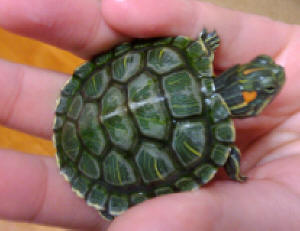 |
|
Re: Rot? fungus? shedding? Help! RES
3/15/10
First, Thank you so much for the fast and informative reply!
<No problem!>
Even though RES seem to be a really popular pet here in Japan and
are sold in most small pet shops finding anywhere that sells the
right equipment and the staff actually know anything about them
is impossible! Most websites seem to be trying to scare people
from buying RES so make it sound like if the water even gets a
little dirty they'll die!
<Not at all. They have a very high tolerance for our mistakes
as long as we catch them and correct them>
The reason I am changing about 50% of the water every other day
is that algae seems to build up incredibly fast in the tank even
though I am feeding them in a separate container, also, even
without algae there is a white residue that covers everything by
the end of the week.
<There are two possibilities here -- maybe both are true: 1)
the very hot water will grow algae much faster than colder water
2) the water in your area may have minerals or other chemicals or
solids that affect water quality. My suggestion is that you bring
the white residue to the attention of a really good tropical fish
store that is in your city and/or search for someone who knows
what it is. Whatever is simply annoying to you would be
absolutely maddening to a Tropical Fish keeper, so let's
avail ourselves of lessons they've already learned.>
as for the "graying" areas on midori in the picture I
sent, I've tried to clean it off with a toothbrush like I
have done with algae in the past but it just doesn't even
slightly come off, and wow the turtles don't like being
cleaned! they will bite and snap at the toothbrush while I do it
which makes me think it might be painful.
<Not painful, but probably annoying. It sounds to me like the
normal graying and discoloration that happens as they mature.
Let's ignore it for now and deal with the other
issues>
Today I will put them out in the sunshine because although my
bulb is "full spectrum" I'm worried it was either
UVA or UVB and not both, I remember on the box it saying
something along the lines of "for safety, it contains no
UVA/UVB"(cant remember which!)
<It's worth finding out and getting the correct bulb. Keep
in mind the bulb must not have any glass or screen between its
surface and their basking area> I am feeding them on greens
(usually different types of lettuce) and two types of
pellets(tetra ReptoMin mini and super(which they love!) and
occasionally dried shrimp.
<I raise mine from hatchlings to breeders exclusively on Koi
pellets (same as Repto-min but less expensive) and an occasional
earthworm treat. No need for the lettuce at all>
Again thank you so much for the reply, its a real relief I can
get information from somewhere!
<That's what we're here for!!>
@Darren <Darrel> thanks for the advice, I've lowered
the temp and will try to resist the cleaning!
<Enjoy!>
|
|
Black lines on shell.... 3/1/10
Hi WWM crew:)
<Hiya - Darrel here>
I want to ask about my 3 little terrapin.
<OK>
1. is it ok if the lines at my shell terrapins turn to black and
thick? it is not look like that, at first. it turn to black after
6 days I bought them and until now. I have no idea what causes
make this happen because I change the water once a month n put
filter n UVB lamp n occasionally bring them to bask under real
sunlight.
<Yes, it is normal for the margins between the scutes to
darken or sometimes to lighten. These normal lines will appear
straight, even and smooth and are very distinct from any sort of
fungal growth, which will appear as irregularly shaped
"blotches.">
<I'm also including a link regarding general care. From
your pictures it looks like you're doing a good job, but
please check your care against the recommendations, just to be
sure.>
<http://www.wetwebmedia.com/FWSubWebIndex/RESCareBarton.htm
>
2. the same question I have asked before, what happen to Gaga
shell? the white things still cannot be remove but it looks like
the colour white fading each day.(because now I can see her green
shell than before)
<I'm not sure what you asked "before" but white
things sounds like possibly a fungal infection? Just in case,
I'll include a link for treatment of common
illnesses.>
<http://www.wetwebmedia.com/FWSubWebIndex/treating%20RES%20Dis%20DarrelB.htm
>
3. the same question but different terrapin. my Gozira and my
Gamera had a red spot under his carapace. maybe it because of the
brick that I put inside the aquarium, but Gozira really a shy
terrapin that doesn't always show himself up but happily hide
from human being.(he favourite spot is under water next to my
filter). so what maybe it is?
<Red spots usually fall into two categories and the most
common is just what you think it is - a stain from scraping
across a brick (which is a favorite item to use as a basking
rock). This is nothing to worry about.
Red on the outside can also be blood, from a cut of scrape. As
long as Gozira is active, eating, swimming & basking -- and
the spot does not increase in size, it is nothing to worry
about>
patiently waiting your reply.
thanks!
<Welcome!>
|
 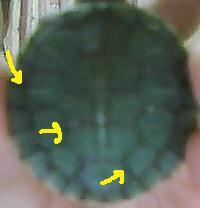 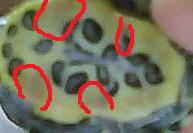 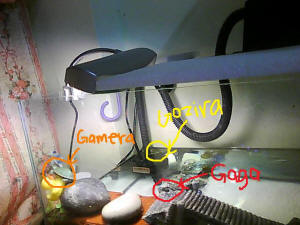 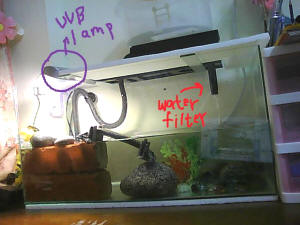 |
Yellow Bellied Slider Spots -- 01/30/10
Hello,
<Hiya - Darrel here>
I have 2 yellow bellied slider turtles. My father bought them for my
family in Florida in August of 2009 and brought them to my children (6,
4, & 2) in MA for a souvenir.
<Dad's heart is in the right place, but he should know that
animals don't make good gifts. Let's just be thankful Dad
didn't go to Africa!!!!!>
The turtles WERE very small...about 1/2 dollar size. Needless to say I
am the care taker of the turtles (and actually have become very fond of
them). Not knowing a thing about turtles, I am doing my best with help
from the Internet and pet stores (although I now realize the staff of
some of the chain pet stores are not as experienced with some pets as I
had thought...one staff person told me to feed my sliders on the dock
in a dish so the water would not get as dirty.) They have been doing
well. They are now about 3 inches, one being slightly bigger than the
other...but always has been. They have been fed mainly ReptoMin food
sticks and a few other types of store bought pellet food. I have not
yet introduced any vegetables.
<Not a problem. I raise them from hatchlings to breeders on
Repto-min, Koi pellets and an occasional earthworm. If you think about
it, they don't get Collards, Romaine, Carrots or squash in their
natural environment anyway.>
For most of their lives, about the first for months that I had them,
they had been in a 10 gallon tank, about a third full with a dock and a
basking light. The light I had used was one that I had used in a chick
brooder...with a 120 watt bulb. They seemed to thrive although after
reading more and more, I recently changed their light to a reptile UV A
light especially made for basking...75 Watts. (I keep nothing on the
bottom of the tank, which helps in keeping them clean and use a Power
Filter for a 40 gallon tank.)
<Sounds really good so far. UV-A is close to the "black
light" effect we're used to from the seedy bars and nightclubs
we hang out in ('¦ er '¦ ah '¦ so I
hear anyway!) and that light is beneficial to reptiles, but UV-B is
CRITICAL to their welfare. You get that from direct, unfiltered
sunlight or a dedicated UV-B bulb.>
I have noticed that the turtles are not basking as much as they used to
(although they are basking). They spend more time under the dock in the
water...a reaction I would expect if I increased the wattage of the
bulb. It is mid winter and I wonder if they just want more time with
the light off? It had been on 12-14 hours a day...I am trying to make
sure I shut it off earlier now (12 hours max.). They do not have a
heater for the night. I was advised that I would not need one if I had
not used one all along. We keep our home at around 70-72 degrees in the
winter.
<Water temp is great. A 75 watt basking light should be warm enough
assuming it's close enough. Besides, when the lamp is too cold,
they bask LONGER, not less>
Is this normal winter behavior?
<As far as winter versus summer cycles, that would have a lot to do
with the bigger picture. If they're housed in a room that gets a
lot of natural lighting (say - the living room) and therefore they are
exposed to the shorter-day light cycles from outside, then they will
tend to cycle as well. So far '¦ as long as they ARE
basking, eating and active and their shells are nice & hard
'¦ I'm hearing only good things. (go buy a UV-B
bulb)>
Their markings have changed as well. On their (yellow) plastron one
only had two dark (blackish-green) marks near the neck while the other
had several all along the out line of the plastron (yellow side). My
son had noticed that the turtle with several markings has "lost
some spots" which I read is normal...but the other turtle has
"gained" two, smaller, lighter brown spots above the two it
already had. The markings are very symmetrical. They are not raised and
don't look to be troubling...but is this normal?
<yep>
That same turtle also has 4 new tiny silver marks (iridescent like) on
the top part of it's shell, spread out evenly at the edge of
it's shell head side (very symmetrical as well). They are recent by
a week or so...if that. Is this normal?
<Sounds like he's ready to shed those scutes. So far --
normal>
The markings do not resemble anything that I have read about on the
Internet that have to do with fungus, bacteria, or shell rot.
<so far -- all good>
Should I go back to the light that I thought was "too bright and
hot". They seemed happier in some way.
<There's nothing wrong with trying it. One of the things that
I've learned is that we go with whatever works! Try it, so how
things change>
I know I need a UVB light, but have to wait for tax returns (they are
expensive).
<Not really. My old "standby" was a $12 Vita-Lite bulb in
an $8 florescent fixture from my local building supply store. Vita-Lite
now make full spectrum CFL bulbs that screw in a standard socket for
around that same price. They're not AS well suited to raising
turtles as the more expensive bulbs like Zoo-Med but when I was a
starving student and it was what I could afford '¦ it got
the job done.>
What is the best and easiest light to get...a combo of UV A/UV B/
basking? Any recommendations?
<Right now, I'd place the 75w basking/UV-A lamp (or the chick
brooder bulb) side by side with a $13-$18 Duro-Test brand Vita-Lite
Compact Florescent.>
I get a different answer from every pet store employee that I ask.
<I understand that. MY answers are also known in the industry as the
"right"¢" or "Correct"¢"
answers!>
I don't think this situation calls for a vet, but I don't know
for sure. I hope to keep them happy and healthy without a Vet visit.
Money is an issue, but I would do what it takes to keep them
healthy.
<You sound like you're doing very well!>
I am concerned about the markings and would like to stop a bad
situation if one has begun. Thank You In advance,
Meg
<Meg - here's a link to an incredibly well-written article on
the care and keeping of Red Eared Sliders, which are identical in need
as far as care is concerned. It sounds like you're already doing
everything right!>
< http://www.wetwebmedia.com/FWSubWebIndex/RESCareBarton.htm>
"Smart Turtle Peoples"
<crew@wetwebmedia.com>
Subject: Hello I need some help please!!!
RES shell... 1/29/10
Hello my name is Tyler
<Hello Tyler,>
and I have to red eared slider they are shedding their shell alot
<Second person today to use this "alot" word. Is it
something they teach in American schools nowadays?>
and I seem to have these very thin pink worm thing in my tank with
white heads I dont know what they are but I need to know if I should
take them to the vet I really need help please.
thank you, Tyler
<It is normal for turtles and terrapins to shed scutes (the
"plates" on their shells) periodically, and they do shed
small flakes of skin almost all the time. However, if more than one or
two scutes are coming of the shell at any one time, and especially if
the shell has a musty smell or has slimy, soft patches, it is possible
your turtle has Soft Shell Disease (Shell Rot) or a fungal
infection.
http://www.wetwebmedia.com/FWsubwebindex/turtshellrot.htm
Taking it to the vet would be very wise indeed. As for worms in the
aquarium, are these flatworms sliding along the glass, or white worms
wriggling through the substrate, or pink worms that sit in the
substrate with half their bodies in the water wiggling from side to
side? Flatworms are mostly harmless, but mean the tank is dirty. The
white worms in the substrate are nematodes, and again, are usually
harmless but do mean the tank is dirty. Some of these nematodes can be
parasitic though. As for pink worms, these are Tubifex worms, and tend
to mean the tank is really, really dirty. So, I'd start by giving
the tank a really good clean, perhaps replacing the gravel with new
gravel. I'd also think about whether the filter is big enough.
Review also the size of the aquarium. Adults need very big tanks,
something like 55 gallons. Do read here:
http://www.wetwebmedia.com/FWsubwebindex/redearsliders.htm
http://www.wetwebmedia.com/FWsubwebindex/RESCareBarton.htm
Cheers, Neale.>
RES Soft shell issue 1/26/10
Hi guys,
<Hiya - Darrel here>
Last time I posted you helped me through, now again I need your
help.
<Once - was lucky! You think we're good enough to go two for
two??>
One of my RES has soft shell on different locations, when I noticed I
immediately took action as your advice. But certain stuff are missing,
I cannot find a UVA light (looked all around the city) and strangely
but true no different type of calcium but the ones that you have to put
in water to dissolve, so the current conditions are:
1. Isolated in a box
2. Light with temperature max reaches 30 degree Celsius
3. Room temperature during light off is 23 degree
4. Eyes are closed but when RES awaken it manages to open so I'm
giving pellets with vitamin A + D (2-3 pellets / 3 times per week)
5. Twice a day I'm putting it in water so it can drink the water
rich with calcium (seems like the RES loves it a lot cant get enough of
it).
6. No sunlight its winter and cloudy constantly here <basically
good. What you need is UV-B light and you should be able to find a bulb
or florescent tube at any pet shop or from many different sources
on-line>
The thing is that its been almost two weeks and I cannot see any
improvement on the shell its remaining the same... Don't ask to go
to the doctor I've been to more than 4 of them when I go there they
start laughing that someone is actually bringing a turtle to cure (I
know IDIOTS). So pretty much I'm on my own with a sick turtle
(again). Need advice ASAP I don't want anything bad to happen since
I love my RES as if they were my babies.
<We understand. First, by having him warm and DRY, you are
preventing the situation from getting much worse, much faster. This is
a good thing.
I've never had experience with Calcium in the water actually doing
any good -- it needs to be in the diet -- but if he seems to like it,
it can't
hurt!>
<Next, feed him all he'll eat of the vitamin enriched pellets
every day>
<The only thing I'd change is to get him under a UV-B lamp for
at least 14 hours a day. The original Vita-Lite by Duro is a good
standby UV-B bulb.
There are better, more focused, but I've literally raised hundreds
of turtles, tortoises and iguanas that have known no other UV-B
source.
Zoo-Med's Repti-sun bulbs are an even better choice.>
Thanks
<Yer welcome!>
P.S. one doctor actually advised me to put it on hibernation???? I
don't think so !!!
<Do not go back to that doctor>
|
RI and spot on carapace? RES shell and resp. hlth.
1/22/10
Hello wet web media crew.
<Hiya - Darrel here>
Noi here. thanks for your respond before about my lovely
terrapin:) it does really help me to more understanding about
this wonderful pets:)
but, I want to ask more questions in this mail about problems
that appear to my another terrapins. I've attached the
picture so you can see my real situation.
The first picture(Gammy 1) shown that my gammy open his mouth and
wheezing and breathing loudly and I suspected his get Respiratory
Infection. its been raining this few days and the temp get cold
and his starting to behave like this 2 days ago.
I then put him in another container to separate him from my
another terrapin. what I want ask is, does he really get RI and
what can I do to treat him because there is no vet at my place:(
is it other alternative treatment that I can do?
and I also wonder it is he get RI because of his mouth have a
hole(Gammy 2) (I don't realize about the hole when I buy him
from pet shop) and make it easy for the water get into his
mouth.
<Treating a respiratory infection is not hard, Noi. If the
infection is not too advanced it can clear up without any
expensive treatment. Here is a link on how to treat common
illnesses. Isolate Gammy someplace warm and dry and keep his
temperature high. Read about isolation and Wheezing and Bubbly
Nose>
<treatment:
http://www.wetwebmedia.com/FWSubWebIndex/treating%20RES%20Dis%20DarrelB.htm
>
<The hole in his mouth is a much more serious condition!
Unfortunately I can't see anything clearly from the photos
you sent. Please describe it in more detail and / or try to take
a closer photo (while still in focus) of the area. IF it is a
wound, the link on treatment has a section on wounds and
abrasions and also, keeping him warm and dry will help that heal
as well>
another question I want to ask is, what could it be spot on gammy
(gammy2) n gaga (gaga pic) carapace? when I buy gaga from pet
shop n I already ask the pet seller about it and she said that it
just shell skin shedding. is it true? because it about 2 weeks
and still nothing change (the spot just remain like that). and
how about Gammy spot? looks like algae but I'm not sure.
patiently to hear your feedback about it.
<Again, the pictures are not clear. It may simply be abrasions
from rubbing on the rocks. While treating Gammy, treat Gaga as
well - for a fungal infection. Those spots may not be fungus, but
it doesn't hurt to treat him as if it was. Warm & dry
will help them heal!>
anyway thanks!:)
|
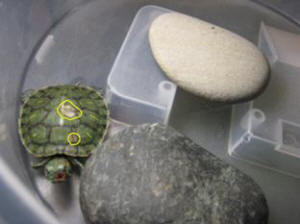 |
|
Red spot under my terrapin
1/17/10
Hello there WetWebMedia crew.
<Hiya - Darrel here>
I've attached picture of my terrapin that have red spot under
her plastron.
it appeared about 1 week ago, and I try search in internet about
what it is, but nothing seem to satisfy me. I put her on aquarium
with a place to bask, a filter and change water once a month and
even though I still cant afford to put an UVB lamp, but still
I'll take her bask outside (from 8-9am) everyday. she's
also active, eating and discharge it. please help me to find out
what red spot could it be?
<The carapace & plastrons of turtles and tortoises is
living tissue. It's like our keratin (fingernails) but it
does have a blood supply. For this reason it's always a
concern when the plastron takes on a pink tint -- it can mean
sepsis, which is a fancy word for an infection that has spread to
the blood. Also known as Septicemia -- it is an indication of an
infection that is very advanced and extremely difficult to
treat.>
<In your case, a healthy looking and active turtle .. one that
is eating well and that looks bright and alert -- probably does
not have Septicemia!
It's more likely that some of the red coloring from the
bricks in the basking area is simply rubbing off and becoming
embedded in the tissue.>
thanks:)
<Your welcome!>
|
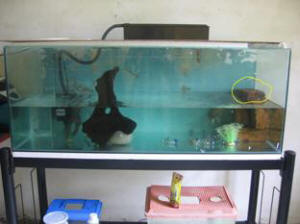 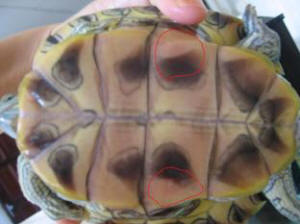 |
|
Sick turtle, RES, shells 12/31/09
Hi,
<Hiya -- Darrel here>
I bought 2 Red Eared Slider turtles last month, female (Chloe)
and male (Ernest).
I don't really check on them before buying (I'm no
experience on this),and I just brought them home. Lucky me, I
have my female slider in a good condition, her shell is really
pretty and has a good color while my male is not really good. At
first, I didn't really notice it, but now it become clearer
that he has white spots on it's shell and black spots. (lucky
me it's not strips or it'll become a zebra-turtle)
<they look PINK to me -- more than white>
After doing some searches, I think the white spots is because of
fungus, so I put Betadine on it's shell and keep him dry for
most of the time, just feeding and bathing keep him wet, but the
spots haven't gone yet (but this was just 3 days ago, I
don't know if I need more time to see the result before
judging). The worst is the spots getting on the other part little
by little. And I have no idea with the black spots. With seeing
the female, which is in a good condition, I can see that this
black spots is not normal (but I'm not sure calling it spots,
cause it's just sliding over the shell shape, and sometimes
it's big). I've tried to wipe it, cause maybe it's
algae, but it won't go away. Their appetite is good, even the
male is really starving. I've throw everything in it's
tank and it'll eat everything that come down but I now I
don't feed it too much, I'm afraid it'll get too fat,
and he is. They are moving actively too. It just like they're
not sick, if it's shell don't appear differently. The
male do not smell, even it's a good smell because of bathing
but the female do. But after bathing, she don't. Sometimes
she won't eat, sometimes she eat, and sometimes always sleep
even when basking. I'm afraid she got respiratory infection
but I have no courage to open it's mouth to see the color to
know if she's sick or not. They're only 5 months old and
so tiny.
<I think that Ernest may have a bacterial infection. The PINK
color on the areas of his shell is more like we see when the
turtle is septic. This is not a good thing, but don't give up
hope. Most of the treatment you're doing is good to help him
fight a bacterial infection, too. Please read here:
http://www.wetwebmedia.com/FWSubWebIndex/treating%20RES%20Dis%20DarrelB.htm>
The female RES has darker shell than the male, I don't know
if it's because of illness or not. And they haven't get
sun bath for at least three weeks or maybe a month. It's hard
to get sunshine nowadays on December cause it's always rainy
in my country, and I cannot find a UV-B light bulb here, but
I'm still trying to search for it. I just can get them an
ordinary light bulb to keep them warm.
<They do need a basking light for warmth, but you are correct
in knowing that they still need the UV light>
I put them separately now for they fighting and pecking. Not each
other but the female does. Lucky me he's not hurt or
bleeding. Sometimes I scold her when she does this (when
they're bathing, they're together again), and then she
will cover herself with it's shell and not doing it again (or
maybe she's afraid with me), but sometimes she's still
trying it.
<They're behavior isn't anything to worry about at
this point>
I'm attaching some pictures for you, hope they'll help. I
can't afford a good camera, so it's a little blurred,
sorry. But it's clear enough to see the spots.
<The only thing I would suggest next time to get better focus
is to take the picture from just a bit further away. But
they're good enough to see the spots>
I'm desperate with their condition and want to heal the as
soon as possible.
Hoping always for answers,
Stealish
<In your position, I would treat them BOTH for bacterial
infection. Keep them both warm & dry, allowing them to bath
and eat twice daily as long as they are both active and hungry.
Continue your search for a UV bulb because exposure to UV is
critical to their long term recovery. Pay attention to their
diet, make sure it's healthy and appropriate -- and for that,
read here:
http://www.wetwebmedia.com/FWSubWebIndex/RESCareBarton.htm
And best of luck to you!>
|
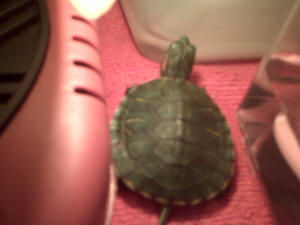 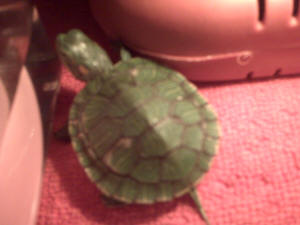 |
|
|

